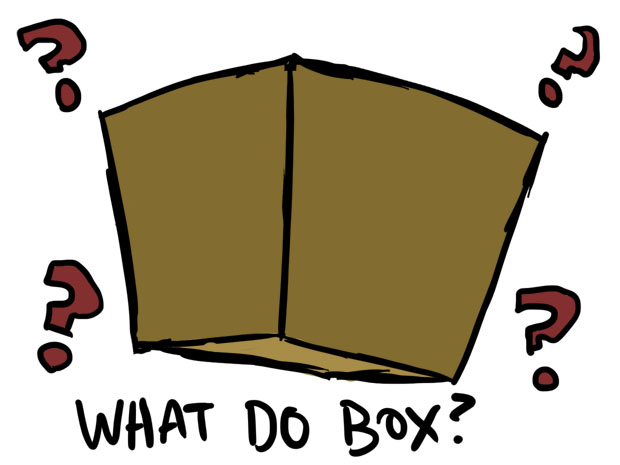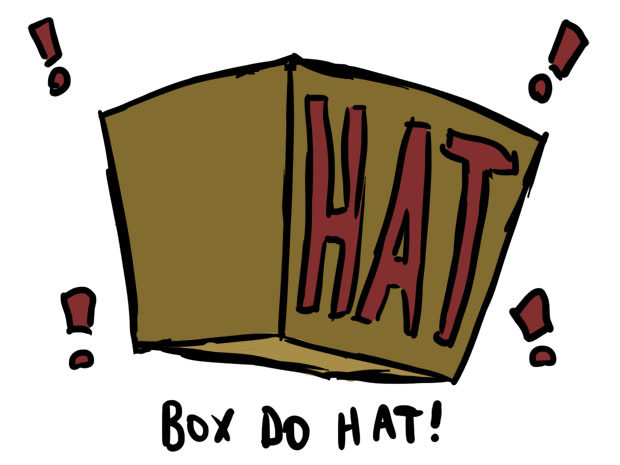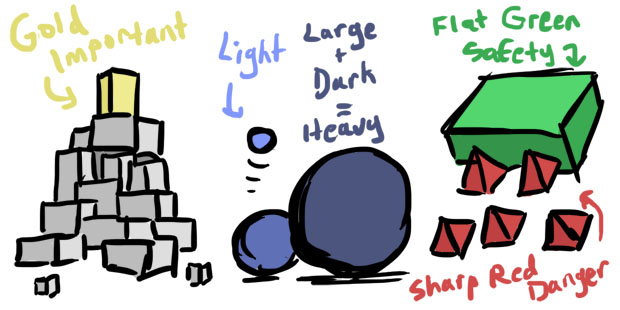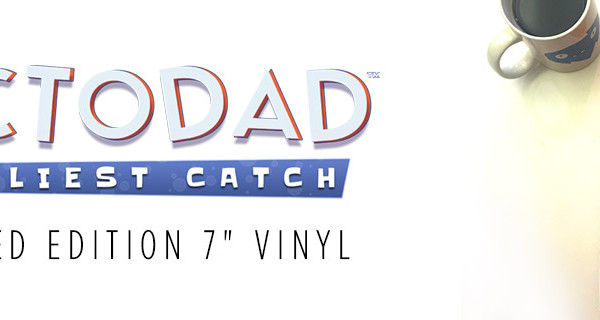A Fistful of Context
We’ve been playtesting Octodad for a while now, and as we’ve been building our first level towards a more-or-less complete state, I’ve noticed something. Gray boxes just aren’t much fun!
I’ve been under the impression for a long time that mechanics are the end-all and be-all of game development, and that any Octodad experience should be just as fun blocked out as it is with art. But that’s simply not true. Something crucial is missing. It’s not feedback or juice, we have plenty of both built into the game. There’s a difference between picking up a block and picking up a trout.
The difference is context! Context is all of the information surrounding an object or a situation. What it looks like, what it sounds like, where it is, what’s around it, and why. I’ve found that small amounts of information make a world of difference in play experience, sometimes moreso than the mechanics themselves! Why? Well, simply put, mechanics are needed to make the game work, but context is needed to make the players work.
Here’s a quick example of what I mean. Observe a blockout box. It is an object in Octodad that has some very specific mechanics. Can you tell what you do with this box?
How can you tell what special mechanics this box has? You can’t, it’s a box. But what if I give you some context?
The box represents a hat! Well, you know what to do with a hat. You can put it on Octodad’s head! Mechanically speaking, you could always put the box on Octodad’s head. But you have no reason to expect that until you know more of its context.
Context can also be used to create differences between mechanically identical objects. You can give players fun decisions to make without building much gameplay, simply by changing an object’s outward appearance. Take, for instance, these hat-boxes.
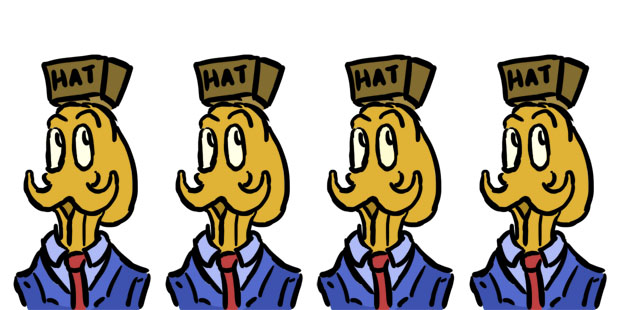 There’s no real reason to pick one hat box over another. But once we define them as different hats…
There’s no real reason to pick one hat box over another. But once we define them as different hats…
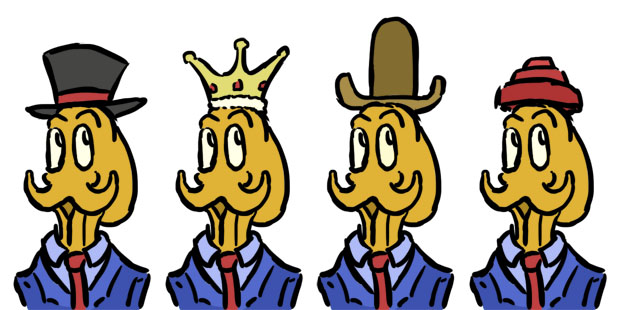 Now you have choices to make based on your preference alone! We’ve found time and time again while playtesting Octodad that there’s something magical about giving a box an identity. Most physics objects are the same box under the surface, but that doesn’t stop players from saying “Ha ha, I’m ruining a cake!“, “Ha ha, I’m throwing a painting!“, “Ha ha, I’m stomping on a book!” each time they encounter a new object to play with. Much of the fun is created in the space between the players’ mind and the game world.
Now you have choices to make based on your preference alone! We’ve found time and time again while playtesting Octodad that there’s something magical about giving a box an identity. Most physics objects are the same box under the surface, but that doesn’t stop players from saying “Ha ha, I’m ruining a cake!“, “Ha ha, I’m throwing a painting!“, “Ha ha, I’m stomping on a book!” each time they encounter a new object to play with. Much of the fun is created in the space between the players’ mind and the game world.
Which leads me to the next point. Context is your means to recreate the mechanics of the game in a player’s mind.
Here’s a visual for you, representing a series of objects and how they are related to each other mechanically.
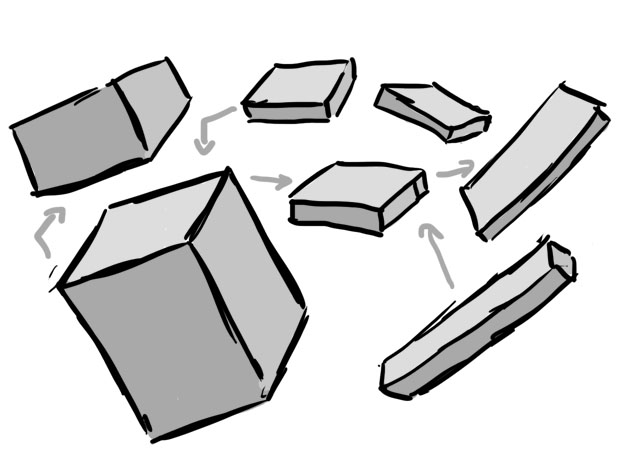 You put one block on another block and over time it turns into a third block which you use a fourth block to put it on a fifth block. The sixth block is attached to the second, but can be pulled off. This mechanical relationship exists within the game system.
You put one block on another block and over time it turns into a third block which you use a fourth block to put it on a fifth block. The sixth block is attached to the second, but can be pulled off. This mechanical relationship exists within the game system.
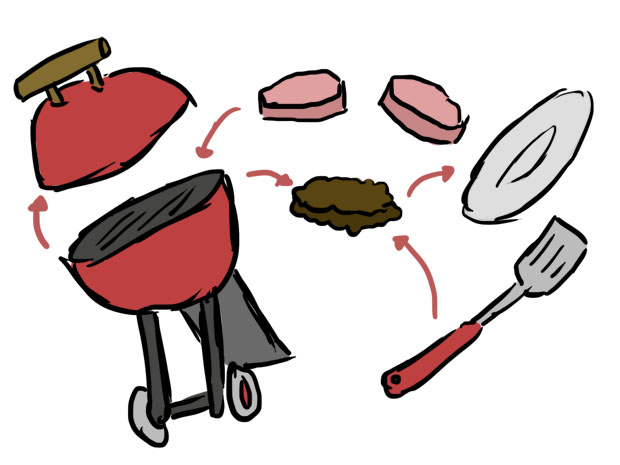 You put a patty on the grill and over time it turns into a burger which you use a spatula to put on a plate. The lid is attached to the grill, but can be pulled off. But of course I didn’t have to explain that. This contextual relationship exists within your mind already. It’s identical to the mechanical relationship, but a great deal more understandable because it uses your expectations of real objects to communicate the different ways they interact. Finding a recognizable context for your mechanics is essential.
You put a patty on the grill and over time it turns into a burger which you use a spatula to put on a plate. The lid is attached to the grill, but can be pulled off. But of course I didn’t have to explain that. This contextual relationship exists within your mind already. It’s identical to the mechanical relationship, but a great deal more understandable because it uses your expectations of real objects to communicate the different ways they interact. Finding a recognizable context for your mechanics is essential.
But we don’t always have access to fancy art assets! That’s alright, you can build context without real-world parallels. The task of connecting ideas in a player’s head can be achieved through the simple application of color, shape, and size. For instance, can you figure out which two objects below are related?
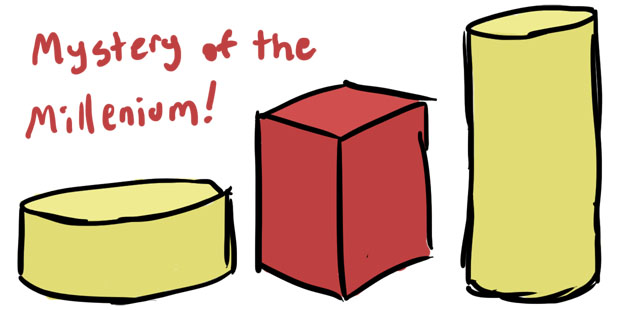 Obviously the two objects that are gold and cylindrical are more closely associated than the red cube. An object on its own can only benefit so much from having a particular color or shape. But within a group of objects, those differences create an understanding within the player as to how they’re all related. It’s also a fine practice to borrow the meanings we already associate with colors and shapes (red means stop, green means go) to further communicate.
Obviously the two objects that are gold and cylindrical are more closely associated than the red cube. An object on its own can only benefit so much from having a particular color or shape. But within a group of objects, those differences create an understanding within the player as to how they’re all related. It’s also a fine practice to borrow the meanings we already associate with colors and shapes (red means stop, green means go) to further communicate.
As a last resort, you always have words. Just as in my first ‘Hat‘ example, even a single word can define a wealth of expectations at once. Reading tends to break the flow of gameplay, so avoid the temptation of explaining every object and its relationships through text. Plus, in cases such as the grill, words can be far less helpful than a visual.
Speaking of words, I sure typed out a lot of them. I’m only just getting into the majesty of proper context, and I learn more about it every day that I work on Octodad! Next time I’m on this train of thought, I’ll get into what the context of story does for us.

